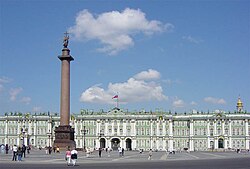This is a list of buildings and structures in Saint Petersburg , Russia.
Contents
- By alphabetical order
- By type
- Bridges
- Churches, cathedrals, and monasteries
- Hotels
- Monuments and memorials
- Palaces and villas
- Shopping malls and markets
- Sports venues
- Theatres
- Towers
- See also
- References





































